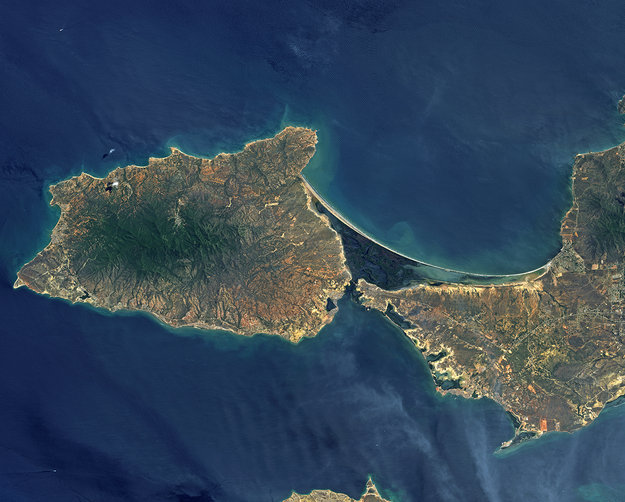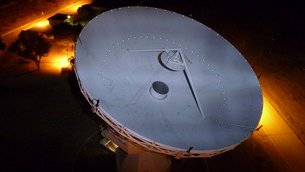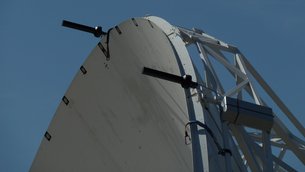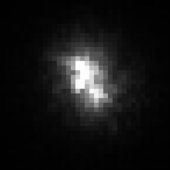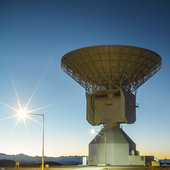Aerial photo of a 25-acre sinkhole that formed
unexpectedly near Bayou Corne, La., in Aug. 2012.
Image Credit:
On Wings of Care, New Orleans,
La.
Analyses by NASA's UAVSAR after the Bayou Corne,
La., sinkhole formed show it detected precursory ground movement of up to 10.2
inches (260 millimeters) more than a month before the sinkhole collapsed. Colors
represent surface displacement (one full color wrap equals 4.7 inches (120
millimeters).
Image Credit: NASA/JPL-Caltech
Sinkholes are common hazards worldwide and are
found in all regions of the United States. This map shows parts of the United
States where certain rock types are susceptible to dissolving in water, leading
to the formation of underground cavities that can result in sinkholes.
New
analyses of NASA airborne radar data collected in 2012 reveal the radar detected
indications of a huge sinkhole before it collapsed and forced evacuations near
Bayou Corne, La. that year.
The findings suggest such radar data, if collected routinely from airborne
systems or satellites, could at least in some cases foresee sinkholes before
they happen, decreasing danger to people and property.
Sinkholes are depressions in the ground formed when Earth surface layers
collapse into caverns below. They usually form without warning. The data were
collected as part of an ongoing NASA campaign to monitor sinking of the ground
along the Louisiana Gulf Coast.
Researchers Cathleen Jones and Ron Blom of NASA's Jet Propulsion Laboratory
(JPL) in Pasadena, Calif., analyzed interferometric synthetic aperture radar
(InSAR) imagery of the area acquired during flights of the agency's Uninhabited
Airborne Vehicle Synthetic Aperture Radar (UAVSAR), which uses a C-20A jet, in
June 2011 and July 2012. InSAR detects and measures very subtle deformations in
Earth's surface.
Their analyses showed the ground surface layer deformed significantly at
least a month before the collapse, moving mostly horizontally up to 10.2 inches
(260 millimeters) toward where the sinkhole would later form. These precursory
surface movements covered a much larger area -- about 1,640 by 1,640 feet, (500
by 500 meters) -- than that of the initial sinkhole, which measured about 2
acres (1 hectare).
Results of the study are published in the February issue of the journal
Geology.
"While horizontal surface deformations had not previously been considered a
signature of sinkholes, the new study shows they can precede sinkhole formation
well in advance," said Jones. "This kind of movement may be more common than
previously thought, particularly in areas with loose soil near the surface."
The Bayou Corne sinkhole formed unexpectedly Aug. 3, 2012, after weeks of
minor earthquakes and bubbling natural gas that provoked community concern. It
was caused by the collapse of a sidewall of an underground storage cavity
connected to a nearby well operated by Texas Brine Company and owned by
Occidental Petroleum. On-site investigation revealed the storage cavity, located
more than 3,000 feet (914 meters) underground, had been mined closer to the edge
of the subterranean Napoleonville salt dome than thought. The sinkhole, which
filled with slurry --a fluid mixture of water and pulverized solids-- has
gradually expanded and now measures about 25 acres (10.1 hectares) and is at
least 750 feet (229 meters) deep. It is still growing.
"Our work shows radar remote sensing could offer a monitoring technique for
identifying at least some sinkholes before their surface collapse, and could be
of particular use to the petroleum industry for monitoring operations in salt
domes," said Blom. "Salt domes are dome-shaped structures in sedimentary rocks
that form where large masses of salt are forced upward. By measuring strain on
Earth's surface, this capability can reduce risks and provide quantitative
information that can be used to predict a sinkhole's size and growth rate."
Typically, sinkholes have no natural external surface drainage, and they form
through natural processes and human activities. They occur in regions of "karst"
terrain where the rock below the surface can be dissolved by groundwater, most
commonly in areas with limestone or other carbonate rocks, gypsum, or salt beds.
When the rocks dissolve, they form spaces and caverns underground. Sinkholes
vary in size from a few feet across to hundreds of acres, and some can be very
deep. They are common hazards worldwide and are found in all regions of the
United States, with Florida, Missouri, Texas, Alabama, Kentucky, Tennessee and
Pennsylvania reporting the most sinkhole damage. While sinkhole deaths are rare,
in February 2013 a man in Tampa, Fla., was killed when his house was swallowed
by a sinkhole.
The human-produced Bayou Corne sinkhole occurred in an area not prone to
sinkholes. The Gulf Coast of Louisiana and eastern Texas sits on an ancient
ocean floor with salt layers that form domes as the lower-density salt rises.
The Napoleonville salt dome underneath Bayou Corne extends to within 690 feet
(210 meters) of the surface. Various companies mine caverns in the dome by
dissolving the salt to obtain brine and subsequently store fuels and salt water
in the caverns.
Jones and Blom say continued UAVSAR monitoring of the area as recently as
October 2013 has shown a widening area of deformation, with the potential to
affect other nearby storage cavities located near the salt dome's outer wall.
Because the Bayou Corne sinkhole is now filled with water, it is harder to
measure deformation of the area using InSAR. However, if the deformation extends
far past the sinkhole boundaries, InSAR could continue to track surface movement
caused by changes below the surface.
Continued growth of the sinkhole threatens the community and Highway 70, so
there is a pressing need for reliable estimates of how fast it may expand and
how big it may eventually get.
"This kind of data could be of great value in determining the direction in
which the sinkhole is likely to expand," said Jones. "At Bayou Corne, it appears
that material is continuing to flow into the huge cavern that is undergoing
collapse."
Blom says there are no immediate plans to fly UAVSAR over sinkhole-prone
areas.
"You could spend a lot of time flying and processing data without capturing a
sinkhole," he said. "Our discovery at Bayou Corne was really serendipitous. But
it does demonstrate one of the expected benefits of an InSAR satellite that
would image wide areas frequently.
"Every year, unexpected ground motions from sinkholes, landslides and levee
failures cost millions of dollars and many lives," said Jones. "When there is
small movement prior to a catastrophic collapse, such subtle precursory clues
can be detected by InSAR."
NASA monitors Earth's vital signs from land, air and space with a fleet of
satellites and ambitious airborne and ground-based observation campaigns. NASA
develops new ways to observe and study Earth's interconnected natural systems
with long-term data records and computer analysis tools to better see how our
planet is changing. The agency shares this unique knowledge with the global
community and works with institutions in the United States and around the world
that contribute to understanding and protecting our home planet.
For more information about UAVSAR, visit:
For more information about NASA's Earth science activities in 2014,
visit:
For information on the latest NASA Earth science findings, visit:



